EDATEC ED-IPC3020 is a fanless industrial computer based on the Raspberry Pi 5 SBC with support for an M.2 NVMe SSD up to 2260 in size, RS232 and RS485 serial ports, and stereo audio input and output jacks.
The Raspberry Pi 5 single board computer could already support an M.2 NVMe SSD thanks to add-on boards such as the PineBerry Pi HatDrive and Pimoroni NVMe Base, but with the ED-IPC3020 we have a complete Raspberry Pi 5-powered computer with M.2 NVMe storage.
EDATEC ED-IPC3020 specifications:
- SBC – Raspberry Pi 5 Model B
- SoC – Broadcom BCM2712 quad-core Arm Cortex-A76 processor clocked up to 2.4 GHz, VideoCore VI GPU, 4Kp60 H.265 decoder
- Memory – 4GB and 8GB LPDDR4X-4267 SDRAM are optional
- Storage – MicroSD card slot for the OS
- Video Output – 2x micro HDMI ports up to 4Kp60
- Networking
- Gigabit Ethernet RJ45 port with optional PoE support
- Dual-band 802.11ac Wi-Fi 5 and Bluetooth 5.0 Classic and BLE
- USB
- 2x USB 2.0 Type-A ports (up to 480Mbps)
- 2x USB 3.0 Type-A ports (up to 5Gbps)
- Misc – Power button
- Power Supply – 5V DC/5A via USB-C port
- Storage – M.2 Key-M PCIe socket for 2230, 2242, or 2260 NVMe SSD. It can also be used to boot the OS
- Audio
- 3.5mm stereo audio output jack (green)
- 3.5 mm stereo audio LINE IN jack (red)
- Serial
- RS485 via 3-pole Phoenix terminal with 120Ω terminal resistor.
- RS232 via 3-pole Phoenix terminal
- Expansion I/Os (internal only, and not useable with the ED-IPC3020 enclosure, but they might be used in a future HMI display from the company)
- 3-pin 5V/1A DC OUT 2.0mm pitch WTB connector for extended LCD
- 4-pin speaker 1.5mm pitch WTB connector with dual channel stereo audio output
- 2x MIPI CSI/DSI connectors (on Raspberry Pi 5) used for extended LCD screen, supporting I2C touchscreen and backlight adjustment
- Misc
- Power LED, ACT LED, 2x green UART LEDs (COM1 and COM2)
- RTC with SuperCAP and CR1220 battery backup
- Buzzer for an alarm function in case of bad configuration
- Power Supply – 5V DC via USB-C port on Raspberry Pi 5
- Power Consumption – 25 Watts (Max)
- Dimensions – 102.8 x 89.5 x 32.5mm
- Weight – 300 grams
- Temperature Range – Operating: -25°C ~ 60°C; storage: -25°C ~ 60°C
- Humidity – 5% ~ 95% (non-condensing)
- Certifications
- FCC 47 CFR Part 15 Subpart B
- EN IEC 62368-1/EN IEC 62311/EN IEC 61000-3-2/EN IEC 61000-3-3
- EN 55032/EN 55035/
- EN 301 489-1/EN 301 489-3/EN 301 489-17/EN 301 489-52
- EN 301 328/EN 301 440/EN 301 511/EN 301 908-1/EN 301 908-2
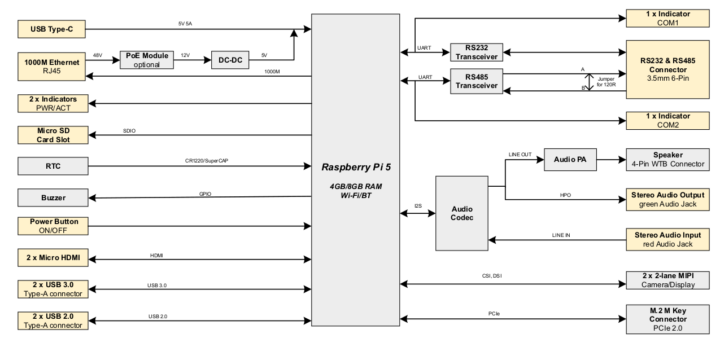
The fanless industrial computer features the Raspberry Pi 5 on one side to access most of its ports and an add-on board for the M.2 NVMe socket, serial ports, RTC battery, and buzzer, as well as speaker and 5V output connectors that will likely be used in a future Raspberry Pi 5 smart display in combination with the MIPI DSI connector on the Raspberry Pi board.
EDATEC says the ED-IPC3020 supports all four variants of Raspberry Pi OS (32-bit or 64-bit, Desktop or Lite) and they likely also provide a script to install any drivers and configuration files required for the additional features. The company sent us a photo of the internal design where we see a large thermal pad used for cooling on the bottom side of the Pi 5 and the M.2 SSD on the add-on board connected to the 40-pin GPIO header and the PCIe connector in some ways.
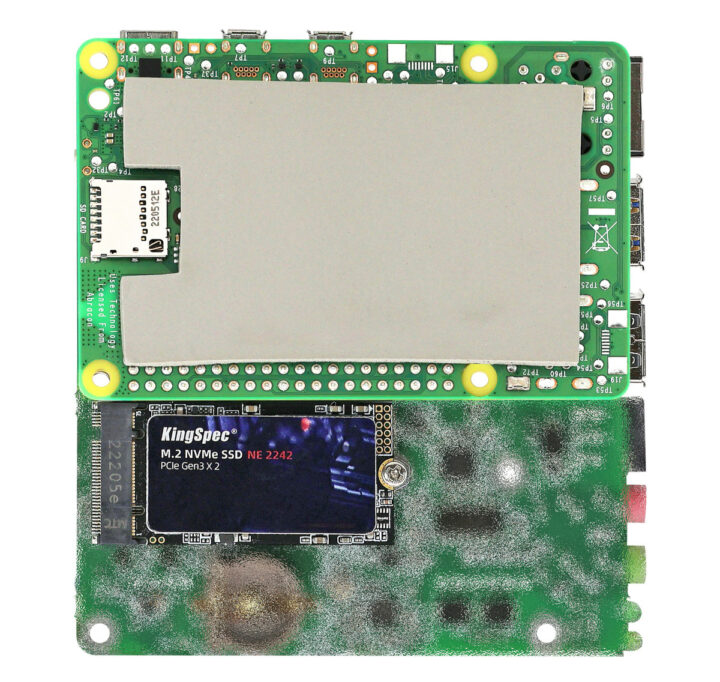 Cooling is further achieved with a heatsink on the top of the Raspberry Pi 5 SBC and a heat spreader on the bottom of the device with which the thermal pad above is in contact. This design would also allow for a thermal pad on the SSD.
Cooling is further achieved with a heatsink on the top of the Raspberry Pi 5 SBC and a heat spreader on the bottom of the device with which the thermal pad above is in contact. This design would also allow for a thermal pad on the SSD.
EDATEC will start shipping the ED-IPC3020 industrial computer in January, but the company is already taking pre-orders for samples on Aliexpress for $165 to $243 depending on the amount of RAM (4GB vs 8GB) and whether a microSD card or a 128GB/256GB SSD is provided.
Further information may also be found on the product page.

Jean-Luc started CNX Software in 2010 as a part-time endeavor, before quitting his job as a software engineering manager, and starting to write daily news, and reviews full time later in 2011.
Support CNX Software! Donate via cryptocurrencies, become a Patron on Patreon, or purchase goods on Amazon or Aliexpress


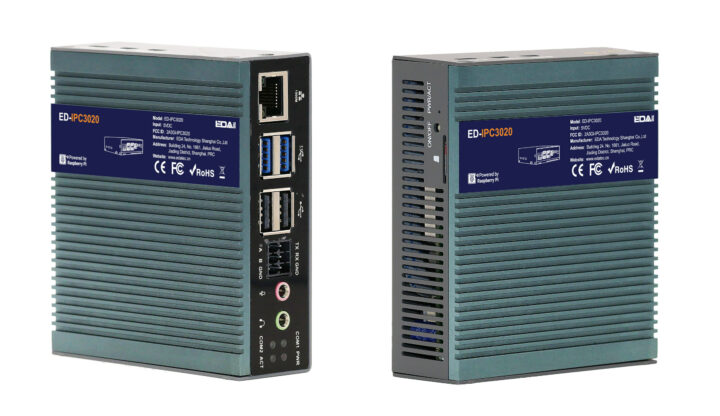
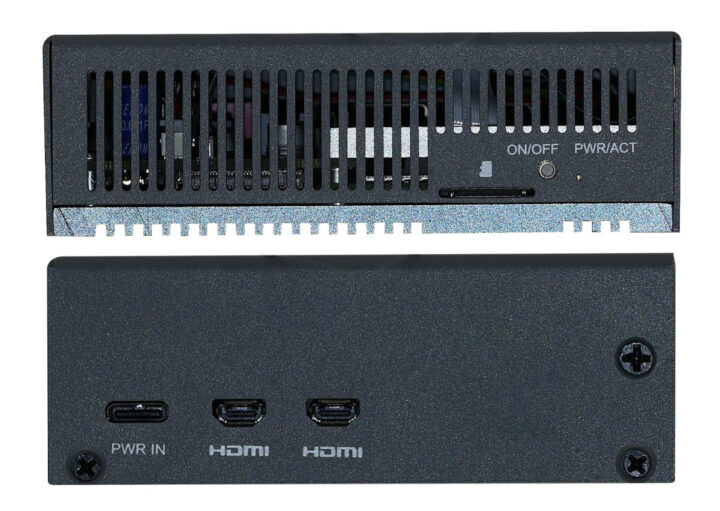
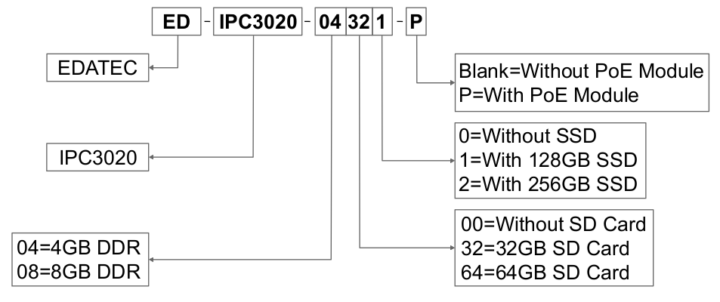



I wonder what makes this industrial computer except its call name? It has nice enclosure, but seems not to have DIN rail mounting, no screw holes on any side, no mentions of any mounting kit for any kind on mouting to common industrial installations like in control cabinets or dashboards. And speaking of electrical interfaces this unit lacks IO (DI, DO, AI, AO). Yes, there are extension IO-boards available with RS485, but how hard gain is support in software. Most of those IO-boards are closed source and software wise bound to either Windows or other proprietary closed software from industrial controller makers like Siemens, Honeywell etc. To me this box looks like just another desktop computer. It cooling and operating temperature range may allow it better work in harsh conditions than a minipc with fan. Thats all I can see for its call name.
I believe that these problems are due to the limitations of the Pi5 itself, and that this device should be designed to maximise the industrial use of the Pi5.
Regarding the mounting I would suppose it is more an industrial PC than a PLC, so rather flying around in a rack than on a din rail.
The proprietary extensions with rs-485 (modbus/profibus) usually are very well documented, they should be easily interfaceable.
But I guess for the pi there is also a codesys runtime available to make it a PLC.
Wonder why don’t they make their fanless chasis dust proof? Why must they expose the internals? Why have the grille?
I think it’s to prevent the metal casing from blocking the signal, and maybe there are heat dissipation considerations as well